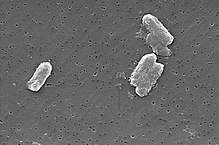Enterobacterales
Enterobacterales with its type genus Enterobacter is an order of Gram-negative bacteria.[1]
| Enterobacterales | |
|---|---|
 | |
| Citrobacter freundii, one member of the order | |
| Scientific classification | |
| Domain: | Bacteria |
| Phylum: | Proteobacteria |
| Class: | Gammaproteobacteria |
| Order: | Enterobacterales Adeolu et al., 2016 |
| Families | |
| |
| Synonyms | |
| |
Historical identification and systematics
Enterobacterales was proposed in 2005 under the name "Enterobacteriales". However, the name "Enterobacteriales" was not validated, thus it lacked standing in nomenclature, so the name should be written in parentheses. "Enterobacteriales" was a monotypic order, containing only the family Enterobacteriaceae, and shared its type genus Escherichia.[2][3][4]
In 2016, "Enterobacteriales" was proposed to be reclassified as Enterobacterales, and the type genus changed to Enterobacter. In addition, several new families within the Enterobacterales were proposed, consisting of species that were formerly members of the Enterobacteriaceae.[1]
Genera
| Phylogeny of Enterobacterales | ||||||||||||||||||||||||||||||||||||||||||
| ||||||||||||||||||||||||||||||||||||||||||
| Phylogeny of the Enterobacterales as proposed in 2016.[1] Pasteurellales is used as the outgroup. |
Validly published genera
The following genera have been validly published, thus they have "Standing in Nomenclature". The year the genus was proposed is listed in parentheses after the genus name.
- Arsenophonus (1991)
- Biostraticola (2008)
- Brenneria (1999)
- Buchnera (1991)
- Budvicia (1985)
- Buttiauxella (1982)
- Cedecea (1981)
- Chania (2016)
- Citrobacter (1932)
- Cosenzaea (2011)
- Cronobacter (2008)
- Dickeya (2005)
- Edwardsiella (1965)
- Enterobacillus (2015)
- Enterobacter (1960)
- Erwinia (1920)
- Escherichia (1919)
- Ewingella (1984)
- Franconibacter (2014)
- Gibbsiella (2011)
- Hafnia (1954)
- Izhakiella (2016)
- Klebsiella (1885)
- Kluyvera (1981)
- Kosakonia (2013)
- Leclercia (1987)
- Lelliottia (2013)
- Leminorella (1985)
- Limnobaculum (2018)
- Lonsdalea (2012)
- Mangrovibacter (2010)
- Metakosakonia (2017)
- Mixta (2018)
- Moellerella (1984)
- Morganella (1943)
- Obesumbacterium (1963)
- Pantoea (1989)
- Pectobacterium (1945)
- Phaseolibacter (2013)
- Photorhabdus (1993)
- Phytobacter (2017)
- Plesiomonas (1962)
- Pluralibacter (2013)
- Pragia (1988)
- Proteus (1885)
- Providencia (1962)
- Pseudescherichia (2017)
- Pseudocitrobacter (2014)
- Rahnella (1981)
- Raoultella (2001)
- Rosenbergiella (2013)
- Rouxiella (2015)
- Saccharobacter (1990)
- Salmonella (1990)
- Samsonia (2001)
- Scandinavium (2020)
- Serratia (1823)
- Shigella (1919)
- Shimwellia (2010)
- Siccibacter (2014)
- Sodalis (1999)
- Superficieibacter (2018)
- Tatumella (1982)
- Trabulsiella (1992)
- Wigglesworthia (1995)
- Xenorhabdus (1979)
- Yersinia (1944)
- Yokenella (1985)
Candidatus genera
- "Candidatus Annandia"
- "Candidatus Arocatia"
- "Candidatus Aschnera"
- "Candidatus Benitsuchiphilus"
- "Candidatus Blochmannia"
- "Candidatus Curculioniphilus"
- "Candidatus Cuticobacterium"
- "Candidatus Doolittlea"
- "Candidatus Fukatsuia"
- "Candidatus Gillettellia"
- "Candidatus Gullanella"
- "Candidatus Hamiltonella"
- "Candidatus Hartigia"
- "Candidatus Hoaglandella"
- "Candidatus Ischnodemia"
- "Candidatus Ishikawaella"
- "Candidatus Kleidoceria"
- "Candidatus Kotejella"
- "Candidatus Macropleicola"
- "Candidatus Mikella"
- "Candidatus Moranella"
- "Candidatus Phlomobacter"
- "Candidatus Profftia"
- "Candidatus Purcelliella"
- "Candidatus Regiella"
- "Candidatus Riesia"
- "Candidatus Rohrkolberia"
- "Candidatus Rosenkranzia"
- "Candidatus Schneideria"
- "Candidatus Stammera"
- "Candidatus Stammerula"
- "Candidatus Tachikawaea"
- "Candidatus Westeberhardia"
Proposed, but have not obtained standing in nomenclature
- Aquamonas (2009)
- Aranicola (1997)
- Atlantibacter (2016)
- Averyella (2005)
- Grimontella (2003)
- Guhaiyinggella (1995)
- Margalefia (2004)
- Tiedjeia (2005)
References
- Adeolu, M.; et al. (2016). "Genome based phylogeny and taxonomy of the 'Enterobacteriales': proposal for Enterobacterales ord. nov. divided into the families Enterobacteriaceae, Erwiniaceae fam. nov., Pectobacteriaceae fam. nov., Yersiniaceae fam. nov., Hafniaceae fam. nov., Morganellaceae fam. nov., and Budviciaceae fam. nov". Int. J. Syst. Evol. Microbiol.
- Zipcodezoo site Enterobacteriales Archived 2014-04-27 at the Wayback Machine accessed 9 Mar 2013
- NCBI Enterobacterales accessed 9 Mar 2013
- Taxonomicon Enterobacteriales accessed 9 Mar 2013